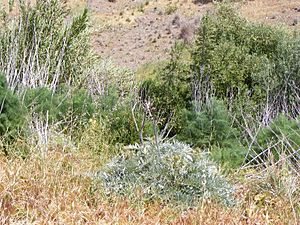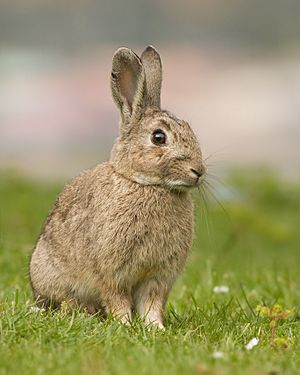Invasive species in Australia facts for kids
Invasive species in Australia are plants, animals, or other living things that have been brought to Australia, either on purpose or by accident. They are not native to Australia and cause harm to the environment, native wildlife, or human activities like farming. These species are a big problem for Australia's unique nature and cost a lot of money to manage.
Many of these species arrived when Europeans first explored and settled Australia, and more have come since then. The Australian government works hard to stop new invasive species from arriving and to manage the ones already here. Controlling weeds alone costs Australia about A$1.5 billion each year. Another A$2.5 billion is lost in farm production because of these weeds.
Contents
Why Australia Has So Many Invasive Species
Australia's plants and animals are very special because the continent was isolated for millions of years. Australia was once part of a huge supercontinent called Gondwana. About 50 million years ago, Australia broke away from Antarctica. It then drifted alone for a long time. This long isolation meant that Australia's wildlife evolved without many of the pressures seen in other parts of the world.
When humans arrived in Australia, first the Aboriginal Australians (between 65,000 and 80,000 years ago) and then European settlers in 1788, new species were introduced. The Dingoes arrived about 4,600 to 5,400 years ago. They likely caused some native animals, like the Thylacine, to disappear.
With European settlement, many more animals and plants were brought in. Some were for farming, some as pets, and some by accident. Because Australia has so much open land and few people in many areas, it's hard to control large wild animals like camels or horses once they escape.
Types of Invasive Species in Australia
Australia faces problems from many different types of invasive species. These include fungi, bacteria, animals, and plants.
Invasive Fungi and Bacteria
Fungi and bacteria can also be invasive. They harm native plants, animals, and farm crops. For example, Phytophthora cinnamomi, also known as wildflower dieback, causes many native plants to die. It is a huge problem in forests and woodlands.
Invasive Animals
Australia has 56 different types of invasive vertebrate animals. These are animals with backbones. They can be called:
- Invasive: Species that spread quickly into new areas.
- Ferals: Animals that were once pets or farm animals but now live in the wild.
- Pests: Animals that directly harm people, the environment, or farms. They often reproduce very fast.
Some of the most damaging and concerning invasive animals are:
| Image | Species | Arrived | Reason | Threat Level | Main Control Methods |
|---|---|---|---|---|---|
| Cat (Felis catus) |
1849 | Pets | Extreme | Fencing, shooting, trapping. | |
| European rabbit (Oryctolagus cuniculus) |
1857 | Hunting | Extreme | Rabbit-proof fence, Myxomatosis, Calicivirus. | |
| Red imported fire ants (Solenopsis invicta) | 2001 | Accidental | Extreme | Movement controls for materials. | |
| Cane toad (Rhinella marina) |
1935 | To control cane beetles | Extreme | Culling, trapping, genetic research. | |
| Red fox (Vulpes vulpes) |
1855 | Hunting | Extreme | 1080 baiting, hunting. | |
| Feral goat (Capra hircus) |
1840 | Farm animals | High | Trapping, shooting. | |
| Feral pig (Sus scrofa) |
1788 | Farm animals | High | Trapping, shooting, poisoning. | |
| Feral donkey (Equus asinus) |
1866 | Pack animals | Medium to high | Culling, fertility control. | |
 |
Dromedary camel (Camelus dromedarius) |
1840 | Pack animals | Medium to high | Helicopter culling. |
 |
Brumby (Equus ferus caballus) |
1788 | Farm animals | Medium to high | Culling, fertility control. |
| Water buffalo (Bubalus bubalis) |
1829 | Farm animals | Medium | Hunting, culling. |
Controlling Invasive Animals
Many programs exist to control invasive animals in Australia. For example, there are efforts to stop cane toads from spreading. Red Foxes, feral cats, and feral pigs are often controlled using poison baits or by shooting. A poison called 1080 is used in some areas. Native animals in Australia's southwest are often immune to 1080 because a local plant naturally contains the same toxin.
Some animals, like deer, can be hunted for sport. Others, like Dromedary Camels and Water buffalo, are often shot from helicopters in large culling programs.
Bounties for Pests
Sometimes, rewards called bounties are offered to people who kill invasive animals. This helps reduce their numbers. Sadly, in the past, bounties were even paid for native animals that farmers saw as pests. This led to the extinction of the thylacine (Tasmanian tiger). It also seriously threatened the Tasmanian devil and Tiger quoll.
Today, bounties are sometimes offered for invasive species like wild dogs (including dingos) and foxes. However, studies have shown that fox bounties might not always work well.
Invasive Insects and Other Small Animals
Insects are the second most costly invasive species group in Australia, after mammals. Fire ants are a huge problem, costing over A$1.2 billion each year. These ants have painful stings and can harm people. Other costly insect pests include the Queensland fruit fly and the bollworm.
Other problematic insects and small animals include Yellow crazy ants, Black Portuguese millipedes, and European wasps. The elm leaf beetle harms imported elm trees. To control it, a parasitic fly was introduced in 2001.
Controlling Invasive Insects
Controlling fire ants is very hard, but they are mostly contained to South East Queensland. European honey bees and European wasps are now so widespread that they cannot be removed from Australia. Honey bees can take over nesting spots that native animals need.
Yellow crazy ants are a big problem on Christmas Island. They kill and displace crabs on the forest floor, harming the island's unique ecosystem.
Invasive Birds
Some introduced birds are considered pests. These include the common myna, the common starling, and the rock pigeon.
The common myna was brought to Australia to control locusts. However, it breeds very quickly in cities. It is now listed as one of the world's 100 worst invasive species. Mynas can spread diseases and mites. They also force native birds out of their nests.
Rock pigeons, often seen in cities, can damage buildings with their droppings.
Controlling Invasive Birds
It has been hard to control invasive bird populations in Australia. However, a program in Canberra has had success with mynas. Since 2006, a volunteer group has trapped over 45,000 mynas. This has greatly reduced their numbers in Canberra. It has also led to more native birds nesting in the area.
Despite the problems caused by rock pigeons, many people still feed them. This helps them breed in large numbers.
Invasive Freshwater Fish
Many invasive freshwater fish species live in Australia's rivers and lakes. These include common carp, brown trout, rainbow trout, and mosquitofish.
Some of these fish have caused huge problems for Australia's native fish and other aquatic life. For example, carp now dominate many lowland rivers in southeastern Australia. Trout species have taken over most of the upland rivers. Carp can live in almost any body of water, making them very hard to control.
Invasive Marine Species
A number of marine pests have arrived in Australia in the ballast water of cargo ships. Ballast water is water taken on by ships for stability. These pests include the black-striped mussel and the European shore crab. The Northern Pacific seastar has caused a lot of damage in places like Tasmania and Port Phillip.
Invasive Plant Species (Weeds)
Weeds are invasive plants that spread into natural areas, waterways, and farms. At first, only plants that harmed farming were called weeds. But now, people also recognize "environmental weeds." These plants harm the natural ecosystem. Australia has a list of 32 "Weeds of National Significance" (WONS).
Weeds cost the Australian economy about A$4 billion each year. They are considered the second biggest threat to Australia's unique nature, after land clearing. Almost half of Australia's declared noxious weeds were brought in on purpose. Many of these were originally garden plants.
Managing Invasive Species
Many different groups work to manage invasive species in Australia. These include individuals, conservation groups, and government agencies.
The Australian Quarantine and Inspection Service (AQIS) works to stop new invasive species from entering Australia. They have public awareness campaigns to teach people not to bring in harmful plants or animals.
Scientific groups like the CSIRO research ways to control invasive species. They have released successful biological controls. For example, the myxoma virus was released to control wild rabbits. Another disease, rabbit hemorrhagic disease, also helps control rabbits. The moth Cactoblastis cactorum was introduced to control prickly pear cacti.
However, some biological controls have not worked well. The cane toad was brought in to control cane beetles. But instead, it ate other things and became a huge environmental problem itself. This has made people very careful about introducing new biological controls.
A more successful example is the Australian Dung Beetle Project. From 1965 to 1985, 23 species of dung beetles were brought to Australia. These beetles help by burying animal dung. This reduced the number of bush flies by 90%. It also improved soil quality.
The Australian government also supports research centers that focus on managing weeds and pest animals. Non-government groups, like the Invasive Species Council (ISC), also work to fight invasive species. Volunteer groups, like SPRATS, help remove weeds from coastal areas.
Economic Impact of Invasive Species
Invasive species cost Australian farmers a lot of money. A study in 2021 found that invasive species had cost Australian farmers A$390 billion over the past 60 years. Feral cats were the most costly, at nearly A$19 billion. Rabbits were next, costing around A$2 billion. Other costly pests include fire ants, feral pigs, and foxes.






